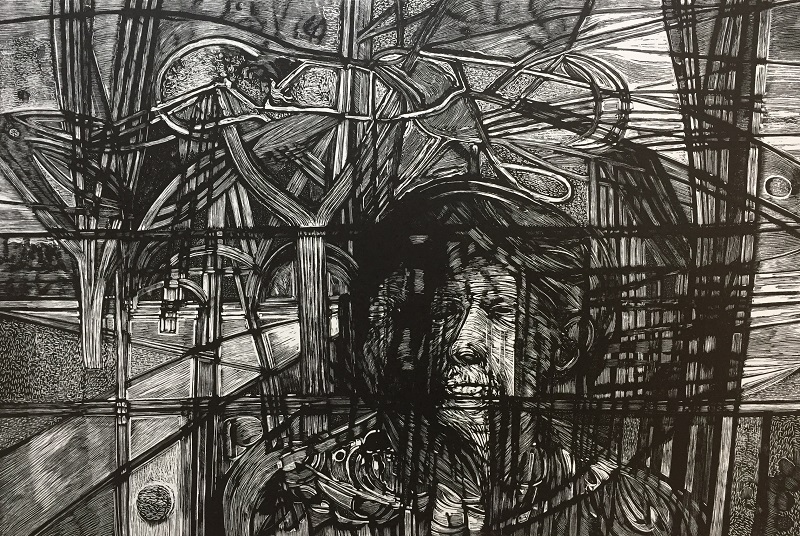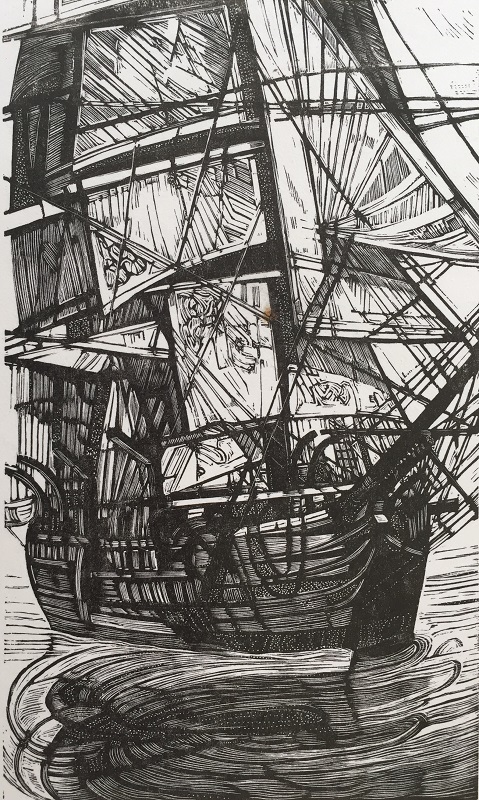Garrick Palmer
60 Years of Art
Paintings, Drawings and Engravings
Thursday 8th March 6-8.30pm
9th March to 7th April 2018
EVENT with Artist Garrick Palmer
Q&A with Garrick Palmer, Friday 23rd March 1pm-2.30pm Portsmouth Museum
Curator Susan Ward talks exclusively to the artist about his early years as an art student in Portsmouth, his influences & techniques.
Advance booking required / Admission Price: £3/ £1.80 with Leisure Card Tel: 02392834744, or email: MuseumsVisitorServices@portsmouthcc.gov.uk
Portsmouth born artist Garrick Palmer has been making paintings, drawings, engravings as well as taking photographs for over 60 years and this solo show aims to encapsulate his singular approach to landscape, story telling and the abstract idiom. A retrospective of intensely coloured paintings of geometric forms emerge from years of landscape printmaking and illustrative work in a progression at first not easy to discern. His consistent motifs are intense repeated patterns, shapes and lines whether depicting plant seed heads silhouetted against a field or the strange mechanical, space age, slightly disturbing forms which inhabit his paintings.
Perhaps unusual in contemporary art Garrick works in the meticulous craft of wood engraving but then confounds one's expectations of what a wood engraver does. These aren't the stereotypical well crafted, decorative images of nature - birds, animals, plants that this artists working in this technique normally depict. His engravings are uneasy, stark visions of unsettling landscapes traversed by trees denuded of leaves against an ordered but turbulent geometrically patterned sky with low wintry cold suns. The technique seems particularly appropriate for his commissioned illustrations for the Rime of the Ancient Mariner and Moby Dick both with their depictions of the claustrophobic rigging, storm tossed ships and dark stories. To learn more about Garrick Palmer's approach to engraving read a recent article he wrote here.
Portsmouth City Museum have a number of Garrick Palmer artworks in their collection and to coincide with this show at Jack House Gallery they have a mounted a display of work dating right back to his time as a student in the 1950s. There will be a talk/discussion by Garrick & Curator of Art Susan Ward scheduled at the Museum the details of which will be provided soon.
Garrick Palmer in conversation with Curator Julie Brown at Pallant House Gallery March 2011
JB What sparked your interest in wood engraving and what inspired you?
GP I studied Fine Art in Portsmouth. A teacher encouraged me to start wood engraving and it has been an interest which has continued throughout my life. I was lucky enough to have been involved with the Curwen Studios in London in the 70s when a lot of well-known artists, such as Henry Moore, were being commissioned to make lithographs, and were always breezing in and out of the studio. I was working on a commission for a New York based publisher while Ceri Richards was there. This inspired my work ‘Self Portrait & Homage to Ceri Richards’ which combines my portrait and the work that I was doing at the time with imagery from a Richards painting. It was interesting for me to meet artists whose work was grand and powerful. You imagine their personalities to be the same, whereas Ceri Richards was in fact very shy and self-effacing, though very talkative when you got to know him, so our work took longer than it should have done! I now feel privileged to have been able to mix in such distinguished company.
JB Has Landscape been a continuous theme in your wood engravings?
GP I have always returned to landscapes as a source of personal fulfilment. They begin as drawings while out walking in particular places in Wiltshire, Dorset, Somerset or Hampshire. However, the works are not specific depictions but rather they are re-interpreted and re-invented from my experiences of these places. I did them for my own enjoyment, but was encouraged to show them to Peter Guy at the Folio Society who was impressed and offered me my first commission as an illustrator. From this, one thing lead to another and I was offered further commissions.
JB A lot of your illustrations have involved the sea such as The Rime of the Ancient mariner and the Sea and The Jungle – were you particularly attracted to this type of work because of your roots in the naval town of Portsmouth?
GP I actually find landscapes more enjoyable than seascapes. But once I was obliged to undertake a commission, such as the Rime of the Ancient mariner for the Folio Society, I commited to finishing it. This work was particularly challenging and took ten years to produce – from the idea to the finished article – as I kept fiddling around with it. There are so many different interpretations to the text and people have such strong, conflicting views on its meanings. ‘The Sea and the Jungle’ was considerably easier as the text is very readable and straightforward to interpret.
JB This show features some works for which you no longer have the blocks – can you explain how this came to be?
GP It’s mostly a personality problem. I am never happy with the end result of anything – some works are simply more passable or respectable than others – and I made hasty judgements about some of my work and had the blocks re-faced. I now regard many of these as acts of folly. I cannot redo the work; the engravings can never be the same twice. These works are more important to me than they were ten or twenty years ago – I have had a re-appraisal of many of them while looking through to select works for this exhibition. The prints left for which I no longer have the blocks are now more valuable and I attach more significance to them. One example is ‘Memory of a Winter Landscape’ which I discovered by chance is held in the collection of Portsmouth City Museums, as I stumbled across it on exhibition a few years ago. I do not have a copy of this work myself and regard this as one of my best landscapes.
JB You said your life story is intrinsically tied up in your wood engraving – in what way?
GP ‘Memory of a Poignant Landscape’ is a good example. On leaving my teaching post at Winchester School of Art in 1987 I took up photography and concentrated on this aspect of my art for the next ten years. My wife, the jeweller Ellis Palmer, was suffering from cancer, and had been going through a particularly heavy bout of chemotherapy in the late 90’s. I realized that it would be better for me to come back into our shared studio and work alongside her instead of hiding away in the Dark Room. Drawing on the block is the most important part of the work, so I spent a considerable amount of time working alongside her on this engraving, to the ultimate benefit of the print. In 1998, before the work was printed, my wife went into a hospice. So, while not immediately obvious, this work is full of hidden meaning and significance to me. Many of the works are undated, but I remember a general period as each holds a specific memory for me of the passage of time.





























